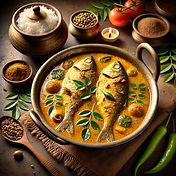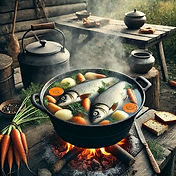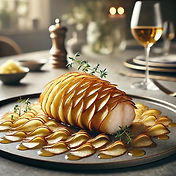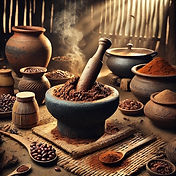
Get recipes ...
Subscribe to our weekly recipes and culinary tips from streamed cooking shows.
Dishes prepared in
Top Chef ™ Destination Canada
Culinary Challenges inspired by
Top Chef ™ Destination Canada
Ecuadorian aji casero is a vibrant, freshly prepared hot sauce that's a staple condiment in Ecuador's cuisine. This zesty sauce combines the heat of fresh hot peppers (typically tree chilis or aji criollo) with the brightness of lime juice, the crunch of finely diced red onions, and the freshness of cilantro.
To make aji casero, the peppers are minced and combined with diced onions, chopped cilantro, lime juice, and a splash of water. Some versions incorporate tomatoes or even a touch of orange juice for sweetness. The ingredients are mixed together and allowed to sit briefly, letting the flavors meld. This versatile sauce brightens everything from empanadas and llapingachos to soups and grilled meats.
Char siu is a beloved Cantonese barbecued pork dish known for its distinctive red hue and sweet-savory glaze. This iconic preparation features pork shoulder or belly marinated in a fragrant mixture of five-spice powder, hoisin sauce, soy sauce, honey, and red fermented bean curd (which gives it that signature color).
To make char siu, the marinated meat is traditionally hung on hooks and roasted in a special oven, allowing the fat to render while the exterior caramelizes to a glossy finish. The result is tender, juicy pork with a complex flavor profile – simultaneously sweet, savory, and slightly smoky. Often sliced and served with rice or added to noodle dishes, char siu is a versatile staple in Chinese cuisine.
Pikliz is a vibrant Haitian condiment that brings a spicy, tangy kick to any dish it accompanies. This colorful slaw combines shredded cabbage, carrots, bell peppers, and onions, all marinated in a fiery mixture of vinegar, lime juice, and Scotch bonnet or habanero peppers.
To make pikliz, vegetables are thinly sliced or shredded, then packed in jars with the acidic mixture and allowed to pickle for at least 24 hours, although many Haitians let it ferment for days or even weeks, developing deeper flavors. The result is a crunchy, intensely flavorful condiment that's essential to Haitian cuisine, perfectly complementing rich dishes like griot (fried pork) or fried plantains.
There is our recipe for Pikliz here.
Ajika is a vibrant, aromatic spice blend originating from the Caucasus region, particularly Georgia and Abkhazia. This fiery condiment combines the heat of red chili peppers with aromatic herbs like fenugreek, coriander, and dried mint, along with garlic and walnuts for richness and depth. Traditional ajika is prepared by grinding dried chilies with fresh herbs, garlic, salt, and sometimes nuts into a coarse paste. The resulting blend offers an intense, complex flavor profile that's simultaneously spicy, herbaceous, and slightly tangy. Used as a marinade, condiment, or cooking ingredient, ajika adds bold character to meats, vegetables, and stews, bringing the distinctive flavors of the Caucasus to your kitchen.
Pirozhki are traditional Eastern European hand pies, particularly beloved in Russian cuisine. These small, portable delights feature a soft, pillowy yeast dough wrapped around savory or sweet fillings. Classic savory versions contain ground meat with onions, cabbage with eggs, or potato with mushrooms, while sweet variations might feature fruit preserves or sweetened farmer's cheese.
To make pirozhki, a yeast dough is prepared, allowed to rise, then divided into small portions. Each portion is flattened, filled with the prepared filling, sealed into an oval or crescent shape, and then either baked until golden or fried until crispy. They're perfect for meals on the go or as comforting appetizers.
Fried kielbasa is a delicious preparation of traditional Polish smoked sausage that transforms this hearty meat into a crispy, flavorful dish. When sliced and pan-fried, the kielbasa develops a caramelized exterior while maintaining its juicy, savory interior. The cooking process releases its garlicky, smoky flavors and renders some of the fat, creating a perfect balance of textures. Home cooks appreciate kielbasa for its versatility - serve it alongside eggs for breakfast, tuck into sandwiches for lunch, or pair with sauerkraut and potatoes for a comforting dinner. It's also excellent cut into bite-sized pieces and served as an appetizer with mustard for dipping.
Aji amarillo is a vibrant yellow-orange chili pepper native to Peru, considered the cornerstone of Peruvian cuisine. With a medium heat level and distinctive fruity flavor profile that hints at mango and sunshine, it delivers warmth without overwhelming spiciness. Home cooks can find aji amarillo as fresh peppers, frozen, dried, or in convenient paste form, which is most commonly available in international markets. This versatile pepper brings both color and depth to classic dishes like papa a la huancaína (potato with cheese sauce), ceviche, and aji de gallina (creamy chicken stew). Its unique taste can transform ordinary sauces, marinades, and dips into something memorably flavorful.
Jeera, commonly known as cumin seeds in English, is a staple spice in many South Asian, Middle Eastern, and Mediterranean cuisines. These small, oblong seeds come from the Cuminum cyminum plant and have a warm, earthy flavor with slight citrus notes. In Indian cooking, jeera is often the first spice added to hot oil or ghee (a process called "tempering") to release its aromatic oils. It's an essential ingredient in spice blends like garam masala and adds depth to curries, rice dishes, lentils, and vegetable preparations. Jeera also has digestive benefits and is sometimes consumed as a tea to aid digestion after heavy meals.
Meen Moilee is a celebrated Kerala fish curry that exemplifies South Indian coastal cuisine. This luxurious dish features firm white fish gently poached in a velvety coconut milk sauce infused with aromatic spices. The preparation begins by sautéing curry leaves, green chilies, ginger, and onions until fragrant, then adding turmeric, ground spices, and coconut milk to create a golden, creamy base. The fish is carefully added last, allowing it to cook just until tender. The hallmark of Meen Moilee is its balanced flavor profile - mild heat complemented by tanginess from tomatoes or sometimes vinegar, sweetness from coconut milk, and brightness from fresh lime juice. Served with rice, this curry represents the perfect harmony of Kerala's abundant seafood and tropical ingredients.
Ukha is a traditional Russian clear fish broth that dates back centuries, revered for its clean, delicate flavors. This aromatic soup begins by gently simmering whole fish—typically freshwater varieties like pike, perch, or sturgeon—with minimal vegetables and aromatics, allowing the pure essence of the fish to shine through.
The preparation is deliberately simple: fish, onions, carrots, bay leaves, black peppercorns, and occasionally potatoes or leeks. What distinguishes ukha is its clarity—the broth should remain transparent, never cloudy. Often finished with fresh herbs like dill or parsley and a splash of vodka, authentic ukha embodies Russian cuisine's philosophy of highlighting natural flavors rather than masking them with excessive seasonings.
Pommes de terre en écailles, meaning "scaly potatoes" in French, is an elegant potato preparation technique that transforms the humble tuber into a sophisticated side dish. Thin-sliced rounds of peeled potatoes are meticulously arranged in overlapping patterns resembling fish scales or roof tiles in a buttered dish. Each layer is brushed with melted butter and seasoned with salt and pepper before the next is added. The assembled potatoes are then baked until the edges turn wonderfully crisp while the centers remain tender.
The result is a visually striking dish with beautiful textural contrast—crispy, golden exterior scales protecting creamy interiors—that elevates any meal with its refined presentation and rich buttery flavor.
Dawadawa is a traditional West African fermented seasoning made primarily from locust beans (Parkia biglobosa), though occasionally from soybeans or other legumes. The preparation begins by boiling the beans until soft, then pounding them to remove the seed coats. The cleaned seeds are boiled again, spread out, and covered with leaves to ferment naturally for 2-3 days. This fermentation process develops a pungent aroma and complex, umami-rich flavor profile. The resulting black paste is typically shaped into balls or patties for storage. Used as a flavor foundation in soups, stews, and sauces across Ghana, Nigeria, and other West African countries, dawadawa adds remarkable depth and nutritional value to countless dishes.
You can buy dawadawa spice here.



























